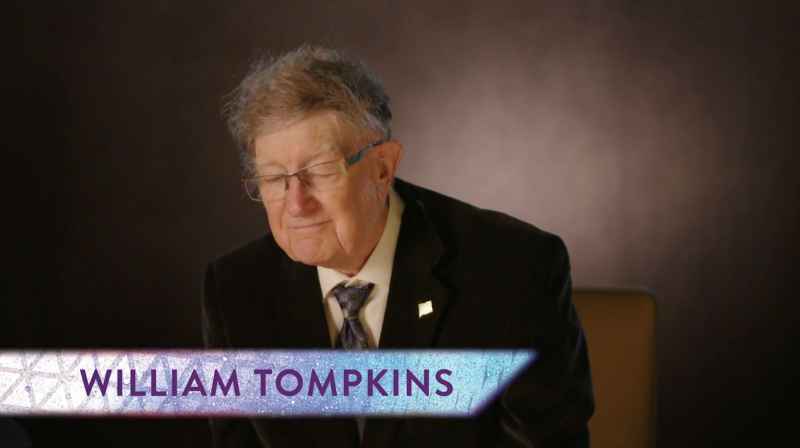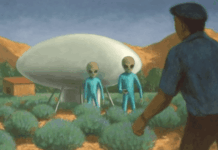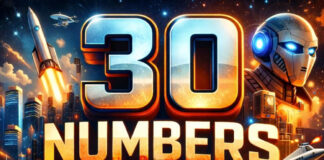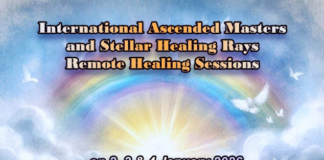
David Wilcock: All right. Welcome back to “Cosmic Disclosure”. I’m your host, David Wilcock, and I’m here with Corey Goode.
And in this episode, we have more of the very stunning new information coming to us from our World War II veteran insider William Tompkins.
* * * * * *
ASTRAL PROJECTION
William Tompkins: When I was just a boy, and I was, like, seven, eight and nine years old, I used to fly a lot. Now, I didn’t have an airplane. I just flew.
We were living in Santa Monica. We were living in Hollywood, and I flew a lot, mostly at night, but a couple of times in class, in school, recess, I’d just go behind the building, and I’d take a flight.
And I’d sometimes . . . I’d put my arms up, but most times I’d just go out.
And so I could fly all over Hollywood, San Fernando Valley, go down to the beach at Santa Monica, fly up to Malibu, fly all the way down to San Pedro, look at the Navy ships and the dry docks in San Pedro, and fly over LAX and come back.
I had a hard time flying over LAX. There was a lot of stuff going on, so I kept myself away from the airports as much as I could.
A few times, after I’d had fun just flying around low key – and in particular, it’s more fun at night with the lights – I’d just shoot out, out into the galaxy. And I flew way above 186,000 miles a second, way, way above that.

And it took everybody a long time to figure out that even the Germans could fly faster than that, and certainly the extraterrestrials could, okay? But what I am saying I do, is I fly out there.
And one time I flew into . . . it the admiral’s command ship of a Reptilian space navy. I flew right into his office. I could see, hear and smell everything that they were saying.
To me, it came to me in English, just like when I flew one time over Russia. Admiral Sergey Gorshkov had been building a whole series of futuristic ships that don’t even look like they’re from the planet because they were built with stealth.
I flew over the base, Vladivostok base, and I actually flew around the base. I went down, looked into the edge of the construction facilities, came back up high, flew into Sergey Gorshkov’s office, and I could see, hear and smell the coffee in his office.

And his language . . . which language? English. All of them were talking English. Okay?
I actually got into a research group in the Navy where I was an adviser to this psychic type of whatever that I’m doing here.
* * * * * *
David: So that’s some pretty interesting stuff there. We’re hearing that he has been able to do this ever since he was seven or eight years old.
And Corey, one of the things that jumped out at me, I was five years old when I had an out-of-body experience. I woke up floating over my body, and it was the event that got me to study ESP.
So I started to do psychic experiments by the time I was seven years old. I wanted to get another chance. I was only able to do it once when I was a kid.
Corey: Yeah, I thought it was commonplace. I thought everyone could do it. I was doing it . . .
David: This was something that happened to you often?
Corey: Mm-hmm.
David: From what age?
Corey: The age of four and five years old it was spontaneously happening, and then I was able to control it through my youth.
We’d be on long car drives. I’d be bored, and instead of asking, “Are we there yet?”, I would just project myself outside of the car, and I would float and fly above the signs as we passed, above the overpasses.
And I thought it was something everyone could do.
David: Is there something about extraterrestrial lineage in the soul that makes it more likely that people will be able to do this?
Corey: Well, let’s say that, in a previous life, you were a more advanced extraterrestrial. You had advanced consciousness abilities, and you agreed to be incarnated here on Earth as a human.
We still have that same oversoul that has the same knowledge. So that knowledge has to slowly trickle into this conscious being that we agreed to become.
David: Is there any reason to believe that if a person goes through excessive trauma, that that trauma might propel them to be able to develop astral projection?
Corey: Yes. That’s actually a technique that is used in the programs. They will cause people to astrally project by inflicting extreme trauma upon them.
David: How does that end up working? Why do you project out of your body then?
Corey: That is a . . . It’s an escape or a protection mechanism that our psyche has. It’s a disassociative ability that our psyche, and we have spiritually, to disassociate and divorce ourself from what is occurring.
And once they program a person through trauma to be able to project out of their body, then they start training them how to do it for operations.
David: And what would be an example of an astral projection?
Corey: Very similar to remote viewing. It’s going to be going to gather intelligence at a remote location.
David: Well, it seems that this is a very ancient technique, isn’t it? I mean, this is something that mystery schools have talked about for a long time.
Corey: Right, it’s a heavily suppressed ability that all humans have.

David: One of the things that, maybe, our viewers are not aware of, there is one particular secret society called BOTA, or Builders of the Adytum, and the Adytum, believe it or not, is a room that has an altar with a sacred book inside with sacred knowledge.

And the room is completely walled off. It’s usually a cylindrical room, all bricked in. You can’t get in at all except in your astral body.
And so the key for the initiate is, can you astrally make it into that room and then read the book inside the Adytum, and only if you can accurately recount what the book says have you then become a true initiate.
Have you ever heard of anything like that?
Corey: Well, I mean, there were similar exercises that we were all put through.
David: Really?
Corey: Yeah. You would have to identify an object in another room, its color. It wasn’t as . . . We weren’t reading books, but you know, we were children.
And they would have us identify toys or paintings or different things in another room that was walled off, and that no one in the experiment, at that time, knew what was in there either. So you weren’t getting psychic hits, or you weren’t front loaded in anyway.
David: Some people might be inclined to dismiss Tompkins’ testimony based on the idea that he’s saying, for example, he went into the office of an admiral of the Reptilian navy, and that he’s hearing things in English when they clearly are not speaking in English.
And the same thing with the Russian where they had these unconventional aircraft, stealth aircraft.
Corey: I have heard of that before, that your mind – your astrally projected astral body – is able to interpret other languages to the language that the mind uses.
David: So there’s sort of a natural translation function going on.
Corey: Not all the time, but some people have that innate ability.
You can’t just astrally project to a lot of these black bases. They’re protected by people that have remote influencing abilities and are enhanced by technology.
I’ve heard them called “Those Who Scatter”. They’ll scatter your thoughts.
Also, shadow beings that will protect facilities from astral projectors. Astral projectors will go try to get into a facility, and all of a sudden they’ll get this real dark being that’s now chasing them all over the place.
So they do have astral security.
David: All right. So in our next segment, we’re going to have Tompkins blast us out into the cosmos, and specifically, we’re going to hear what he has to say about settlements on the Moon.
* * * * * *
OUR MOON
Tompkins: Well, first of all, it’s not your Moon, and secondly, it’s not a moon. It’s a command center for a region of this part of the Milky Way galaxy. That’s what it is.

And it doesn’t rotate. Everybody forgets the thing doesn’t turn. Okay? So it’s not a moon. It’s not YOUR moon. It’s a command center with probably 25~35 different civilizations in there, all of which operate out here for this part of the Milky Way galaxy.
And, yes, some of those people actually are at war with each other, but they have personnel living here. Their families live here. The kids are getting educated. They get young. They get older. They get married. It’s a big hunk. It’s a big facility.
* * * * * *
David: So Corey, what was your reaction as you saw this segment just now?
Corey: It’s exactly what I had stated in the past. There are a number of factions that have territory on the Moon that they operate in. And there will be blood enemies for millennia that are operating within a kilometer or two of each other, I mean, groups that you do not get together no matter what.
David: Now, he mentioned 25 to 35 civilizations. I’m curious how well that dovetails with what you’ve heard?
Corey: That’s probably about right. There are a lot of the genetic farmer races that have ‘observation posts’, is what they call them.
And they do use it as an observation post and a station that they go back and forth doing these genetic experiments on us from.
David: Now, one of the things that jumps out at me was, I kind of thought of this, like you said, as an outpost or maybe a stopover point, whereas he’s saying that you have families living there. You have children being educated there, growing up in these lunar bases.
So we are dealing with what would appear to be like a permanent housing for potentially large populations of people from several, you know, 25~35 civilizations.
Corey: I mean, it would be similar to us having a marine base in Europe. The soldiers have families that are there with them. It’s going to be one of those scenarios.
I had not heard intelligence of families and children. The information I had received was that they were more sort of like military outposts.
David: When I went to Japan, I went to Tokyo, the main city, and it’s amazing when you’re there, and you look out, and you see something that kind of looks like Manhattan, but it is so big.
Tokyo is so incredibly large, there’s such a density of buildings that you can’t even see to the point where that highly compressed density of buildings stops.
So when we have a city of that size, it’s a very small geographical footprint, but you could potentially have 20, 30 million people living there.
I’m wondering if the level of development on the Moon in some of these territories these people have is sufficient enough that you could have a population that large in a small space.
Corey: It’s all about technology. If we were not so technologically developed, it wouldn’t be possible to have a city like Tokyo.
They have mastered all of the energy needs, the protein requirements that people may need, everything that’s needed to process waste on a much more efficient level than we are.
So, yeah, they’re able to have a much higher population density than we are.
David: Are there immigration requirements that would prevent anyone who is not part of their indigenous culture from being able to even see the inside of these cities?
Corey: Absolutely. You don’t have one group going into the cities of others. I mean, it’s like the UN or kind of like how Antarctica is carved up for all these different countries.
It is undisputed territory, and they do not cross over or invade.
The Moon was made sort of like a Switzerland zone, a conflict free zone, after some major, major battles that happened in our history. And they left some of the remnants of that battle on the Moon as a testament and a reminder of the battles and how bad it got.
These are the conflicts that led to these treaties being signed between the different genetic farmer groups, some of these more negative groups that we’re talking about, that allows them to live and operate in close proximity without being at war all the time.
David: Pete Peterson has an insider who came from the Russian space program, who told him that if we were to be able to see the dark side of the Moon – which as Tompkins noted, it’s always against our view. We can’t ever look on that side – that it would look like Manhattan at night.
Meaning the entire circular area of the backside of the Moon, if that circle could be turned towards us, the whole thing at night is just literally covered with lights.
Corey: Yeah, there’s one particular, I think it’s called Luna City, that has a lot of light.
But you have to also note that they have a type of cloaking that goes over their buildings and structures that looks just like the rest of the arid terrain of the Moon.
David: Oh, wow!
Corey: So you could fly over and just see craters when actually that’s a projection over a base or an outpost
David: That is interesting because, as we know, retired Major Bob Dean, according to what I heard from Jacob, my insider who met up with him at a Project Camelot event and recognized him from the Secret Space Program . . .
Corey: I’m pretty sure he did at least one 20-and-Back.
David: Yeah.
Corey: That’s my opinion.
David: But one of the things that Dean said while he was talking to Jacob was that there was an island in the Pacific where half of the island looks like an island, but it’s a cloak, and that there’s a very important base there.
And if it wasn’t for this hologram that makes it look like it’s just an island in the ocean, you’d see this amazing thing.
Corey: Oh, yeah, they can disappear entire islands.
David: Wow! So this is stuff that could be used on Earth right now.
Corey: Absolutely.
David: You can confirm that.
Corey: Yeah. It can be used over Antarctica. It could be used any number of places.
David: All right. Now, he also mentioned that the Moon is a command center. How much of this is also inside?
Corey: Almost all of it. The majority of it is under the surface of the Moon in these deep huge fissures, cracks and lava tubes.
David: And one last thing was you mentioned that we have some new art of the Lunar Operations Command.
Corey: Yes. Yes.

If you look at this image, this is an image that I commissioned that is a 3D rendering of the swastika-looking arrangement of buildings that . . . how the LOC originally looked.

David: Okay.
Corey: And then I have another image that shows how it was built out to cover up the swastika.

David: Interesting. All right. So in this last segment, we have one final set of words from Tompkins for us in this episode, and this is his statements on how he sees our place in the universe based on his own personal and stunning insider knowledge and direct experience with extraterrestrial contact, including Nordics. Let’s take a look.
* * * * * *
OUR PLACE IN THE GALAXY
Tompkins: We’ve now accepted that we have 200 trillion galaxies. Not million. We have 200 trillion galaxies out there.
I mean, what . . . We are so naïve of what’s out there. It’s totally unbelievable. Millions and millions of planets out there – very small things and things that make our Star look like kid stuff.
Our star is just a little dot over on the side – even our galaxy.
And while we’re talking about that, this subject comes up all the time, and it’s an appropriate time to say it.
If we can visualize us as the center of the Milky Way galaxy, we’re reaching out like this with our arm.
Everybody in this room, and all the audience that’s going to be watching this, has to realize this is one of the arms of the Milky Way galaxy. You’re located at my first joint.

You’re not down . . . Wait a minute! You’re not down where the action is. Even in the Milky Way galaxy, you’re not downtown where ALL the action is.
You are out here at this tip, which in time, you’re going to get thrown off because the galaxy rotates. The galaxy rotates, all of them do.
They rotate, so the tips get thrown off. Other galaxies come by, and they pick up that stuff. So you may be going to the next galaxy several weeks from now. Okay? Takes quite a while. [Smiles]
So to realize that you’re not downtown, you’re just one of the castoffs.
This little Solar System thing that you’ve got here – it’s . . . You’re out in the boonies.

And it’s interesting that we have to address who we are, where we are, and what we know and realize that the universe is unbelievable. And so opportunities for young people in this country, all over the world, to be involved in this commercially, okay . . .
Come on. Forget about carrying a big gun. There’s too much of that. That’s not the right step. You’ve got to have the largest . . . enough to be able to stop it, and this is where the Navy has been saying this for 240 years. If you have a large enough navy, they’ll back off.
You don’t need to use a shooting navy. But if you don’t carry that, people are going to really make it hard for you.
And so to me, I think we’re just starting. We’ve just got the tip of the iceberg of where we can go and what we can do, and it’s unbelievable opportunities.
* * * * * *
David: All right. So, wow! That’s a very sobering reminder of the awesomeness of our cosmic identity.
I’ve been quoting from the latest NASA studies, which have revealed that there are as many Earth-like watery planets in our universe as there are grains of sand on Earth, on the entire planet. All the grains of sand put together – there’s a watery planet like Earth out in the universe for all of that.
So it’s a staggering number.
Corey: It’s a template that’s all over the cosmos.
David: And these watery planets in this theoretical mock-up that NASA has put out, they’re looking at, okay, well, maybe one out of a hundred of them is going to have life, and then maybe one out of a hundred of those is going to reach intelligent life.
But based on what you’ve told me before, it seems like intelligent life for a watery planet is far more prevalent than that one out of one out of 100 thing.
Corey: Well, yeah, and also, you have to understand that each solar system has its own dynamics. So there are going to be times of developed societies in the solar system, and then there are going to be cataclysms – cycles that occur.
Then they’ll have long periods of having more basic life that inhabit these planets.
David: And if our conventional estimate of the age of the universe is about 13.8 billion years – there’s different opinions, but that’s one of the common ones – then that would mean that there could be civilizations much older than ours that already reached very high technology.
Corey: Oh, yeah. Come and gone.
David: So the idea that we are the only intelligent life in the universe, in light of all these new statistics, is totally ridiculous.
Corey: Yes, it’s beyond ridiculous. It’s arrogant. You have the right mix of minerals, distance from the sun, the planet being seeded with the correct enzymes or proteins from comets. Then you have all the building blocks for basic life, and it’s everywhere.

And now that they’ve found out that the stars produce water, . . .
David: Right.
Corey: . . . that’s where a lot of the water’s coming from.

And the Sun is also producing the harmonic wave that allows life to come about.
David: Yeah, this is something I’ve done a lot of scientific validation of. If people also watch “Wisdom Teachings”, they’re going to hear, in many of my DNA episodes, astonishing proof.
We went into Wilhelm Reich and how you can, in fact, generate life just out of electrifying a rock and water. All you have to do is that, and you’ll eventually get life to form.
Corey: Right, and also where in the galaxy this solar system is is also going to depend . . . is going to dictate how advanced and how quickly life advances or progresses.
More towards the center of the galaxy, things are occurring a lot quicker. Time is occurring differently.
There’s a lot more going on, civilization wise, towards the center of galaxies than in the cosmic boondocks that he was talking about.
David: I did find that fascinating because my insider Jacob, who was very extensively knowledgeable about the Secret Space Program, claimed to have been to over 200 different off-planet sites, to have seen over 400 different types of extraterrestrials, and he was the guy who gave me a lot of information that correlated so well with what you’ve brought up.
Jacob was telling me that, yes, the center of the galaxy is so much more advanced, and there’s so much more going on there that it’s almost incomprehensible to us.
Corey: Time flows differently. Energy, everything . . . Towards the center of the galaxy, things are occurring, from our perspective, much quicker.
David: Now, Tompkins also mentioned that there were commercial opportunities. It’s not just about going out there with a gun.
What do you think could happen in a post-Full Disclosure world where people will have the ability to potentially even have a portal in their home, and in the course of one day maybe even travel far outside our Solar System, meet with other people, travel to other places? What kind of society is that? What kind of businesses could we start to develop at that point?
Corey: Well, there’s already a lot of commerce going on between our Solar System and the other solar systems, but it’s being controlled by a very militant and fascist group.
If it’s put in the hands of the people, we’re going to be able to do this – start bartering – from our own best interests.
Right now, a lot of the people in the secret space programs are somewhat forced into it.
When it becomes an all volunteer navy-type situation for space, then we’re going to have people that are bringing more creative energy to their mission. And if it’s not a military mission, it’s going to be more of a mission for commerce.
David: Some people watching this show might be cynics, and they would say, “Well, what could we possibly be offering to any other cultures? We’re like Neanderthals, troglodytes, in comparison to these people.
“Even if we developed the portal capability, even if we could pop over to a solar system outside of our own and visit an advanced culture, if they’ve got gigantic buildings made out of transparent aluminum crystal, what are we going to do going in there they would possibly want from us?”
Corey: Well, there are going to be some civilizations that are so much more advanced, there’s nothing that we’re going to really have except for maybe some biologicals or genetic stock that we are willing to trade from our planet.
A lot of them, that’s what they’re interested in. So the more super advanced civilizations . . . we’re not really going to have much that they’re going to want to trade.
But there are a lot of civilizations that are very close to ours. Our level of development is similar to theirs to a point to where they’re buying vessels from us.
We’re engineering technology that nonterrestrial groups covet, they want, and they’re willing to trade for it because we’re known as very diligent and brilliant engineers.
David: Could there also be job opportunities for people who might be, let’s say, artists or musicians or teachers?
Corey: Absolutely.
David: That kind of thing?
Corey: Yeah, I would expect a lot of exchange programs when it comes to the arts, because it’s . . . All the planets have some form of art.
David: And how much of a wide diversity are we looking at of places where artists or teachers or musicians could go and volunteer their services once this opens up?
Corey: Just about every planet that has a human-type civilization. The reason that they tell us not to call them nonterrestrials, or ETs – they tell us to call them people – is because there’s very little difference, genetically, between us and them.
David: Right.
Corey: They are people, and people have desires. They have interests. We can cross-pollinate our sciences, our arts, with other star systems that are interested in our art.
David: So there’s a potential in our future where we could have educational programs, where we’re going to help people to get to a point where they would be welcomed as diplomats, ambassadors, teachers, sharers of knowledge, but it’s going to require us to level up our spiritual maturity before we’re ready for that.
Corey: We’re going to continue to be sort of isolated until we go through this consciousness renaissance. Once we do, and we’re not as damaged, we don’t have as strong of PTSD, then we’re going to be able to go out and interact with them.
David: Well, that’s a very fascinating and hopeful message.
We’ll see you next time here on “Cosmic Disclosure”. Special episode with William Tompkins. I’m David Wilcock here with Corey Goode, and we thank you for watching and supporting us.
Disclaimer: We at Prepare for Change (PFC) bring you information that is not offered by the mainstream news, and therefore may seem controversial. The opinions, views, statements, and/or information we present are not necessarily promoted, endorsed, espoused, or agreed to by Prepare for Change, its leadership Council, members, those who work with PFC, or those who read its content. However, they are hopefully provocative. Please use discernment! Use logical thinking, your own intuition and your own connection with Source, Spirit and Natural Laws to help you determine what is true and what is not. By sharing information and seeding dialogue, it is our goal to raise consciousness and awareness of higher truths to free us from enslavement of the matrix in this material realm.
 EN
EN FR
FR

























